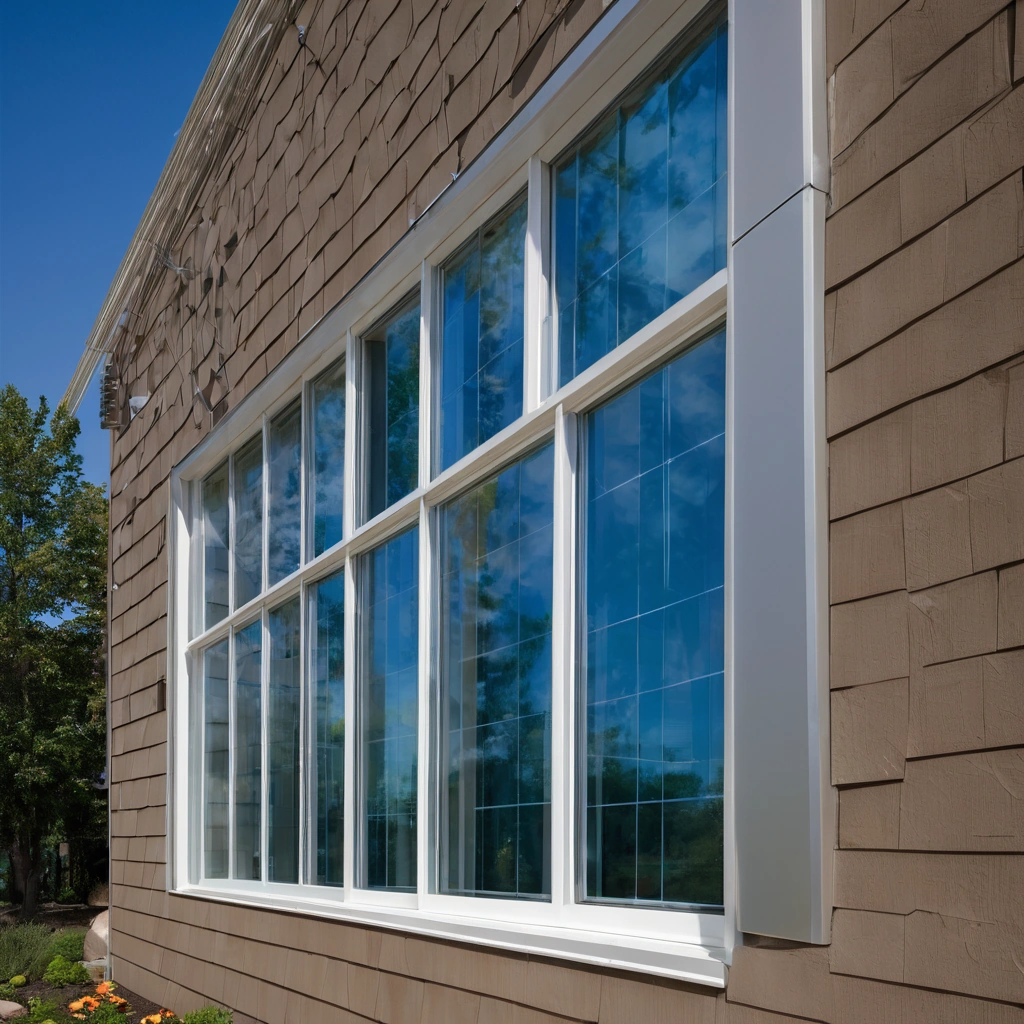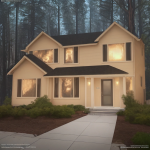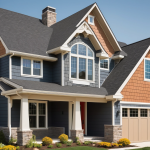Best Low-E Glass Windows for Energy Efficiency in 2024: A Comprehensive Guide
The Future of Energy Efficiency: Low-E Glass Windows in 2024 and Beyond
In the relentless pursuit of energy efficiency, homeowners and contractors alike are constantly seeking innovative solutions to minimize energy consumption and reduce utility bills. Windows, often overlooked, play a crucial role in a home’s overall energy performance. As we approach 2024 and gaze towards the next decade (2030-2039), Low-E (low-emissivity) glass window technologies stand out as a leading solution for residential energy efficiency. This comprehensive guide delves into the science behind Low-E glass, comparing various window coatings, analyzing their impact on key performance metrics, and providing practical recommendations for climate-specific windows.
Prepare to unlock the secrets to a more energy-efficient and comfortable home. The drive for energy-efficient windows is no longer solely about reducing utility bills; it’s increasingly intertwined with broader environmental concerns and the desire for sustainable home improvement. Experts predict a surge in demand for advanced window coating technologies, particularly those that maximize energy savings without compromising natural light. Consider, for instance, the growing adoption of spectrally selective Low-E glass, which allows high levels of visible light transmittance (VLT) while rejecting a significant portion of solar heat.
This innovation directly addresses the common concern that energy-efficient windows sacrifice brightness, demonstrating a commitment to both performance and aesthetics. The window replacement ROI is significantly affected by these choices. The effectiveness of Low-E glass is quantified by metrics like U-factor (measuring heat transfer) and SHGC (Solar Heat Gain Coefficient), both crucial for selecting climate-specific windows. In warmer climates, a low SHGC is paramount to minimize solar heat gain, keeping interiors cooler and reducing air conditioning costs.
Conversely, in colder climates, a higher SHGC can be beneficial, allowing solar heat to contribute to warming the home. The choice between single silver, double silver, and triple silver Low-E coatings further refines this selection process. Each layer of silver enhances the window’s ability to reflect infrared radiation, thereby improving insulation and overall energy savings. Understanding these nuances is essential for maximizing residential energy efficiency. Furthermore, the selection of exterior materials plays a pivotal role in the overall performance of energy-efficient windows.
Vinyl frames, for example, offer excellent thermal resistance and are relatively low-maintenance, making them a popular choice. Fiberglass frames provide even greater strength and durability, while wood frames offer a classic aesthetic but require more upkeep. The optimal choice depends on a combination of factors, including climate, budget, and architectural style. Proper window installation is equally critical; even the most advanced Low-E glass will perform poorly if not installed correctly. Air leaks around the frame can negate the benefits of the energy-efficient windows, highlighting the importance of professional installation and meticulous sealing.
Understanding Low-E Glass: The Science Behind Energy Savings
Low-E glass represents a pivotal advancement in energy-efficient windows, meticulously designed to selectively filter the solar spectrum, minimizing the influx of ultraviolet (UV) and infrared (IR) radiation while maximizing the transmission of visible light. This sophisticated technology employs a microscopically thin, transparent coating, often composed of metallic oxides, applied to the glass surface during manufacturing. This coating acts as a selective mirror, reflecting heat back towards its source, effectively keeping homes cooler during the summer months by rejecting solar heat gain and warmer in the winter by retaining interior heat.
The strategic application of Low-E glass significantly reduces the reliance on HVAC systems, leading to substantial energy savings and a reduced carbon footprint, making it a cornerstone of modern residential energy efficiency strategies. The efficacy of Low-E glass is rigorously assessed using three primary metrics: U-factor, Solar Heat Gain Coefficient (SHGC), and Visible Light Transmittance (VLT). The U-factor quantifies the rate of heat transfer through the window assembly; lower U-factors signify superior insulation capabilities, crucial for maintaining consistent indoor temperatures and reducing energy loss.
SHGC measures the fraction of solar radiation that penetrates the window; a lower SHGC is particularly desirable in warm climates to minimize solar heat gain and lower cooling costs. Conversely, VLT indicates the percentage of visible light that passes through the glass, influencing the amount of natural light entering a room; higher VLT values reduce the need for artificial lighting, further contributing to energy savings. Understanding these metrics is essential for selecting the optimal Low-E glass solution for specific climate conditions and building orientations.
Advanced window coating technologies, such as single silver, double silver, and triple silver Low-E coatings, offer varying levels of performance and are tailored to meet diverse energy efficiency needs. Single silver Low-E coatings provide a baseline improvement over standard, uncoated glass, offering a moderate reduction in U-factor and SHGC. Double silver Low-E coatings offer a more significant enhancement, substantially reducing both U-factor and SHGC, making them a popular choice for homeowners seeking a balance between cost and performance. Triple silver Low-E coatings represent the pinnacle of energy efficiency, delivering the lowest U-factors and SHGC values, ideal for climates with extreme temperature variations or for individuals prioritizing maximum energy savings and thermal comfort. The selection of the appropriate Low-E coating depends on a careful evaluation of climate-specific windows requirements, energy goals, and budget considerations, ensuring that the window replacement investment yields optimal returns in terms of energy savings and home improvement value.
Single, Double, Triple Silver: Comparing Low-E Coating Technologies
The performance of Low-E glass, a cornerstone of modern energy-efficient windows, is intrinsically linked to the type and quantity of silver layers embedded within its specialized coating. These layers act as selective filters, manipulating the passage of different wavelengths of light to optimize energy savings. Single-silver Low-E coatings represent an entry-level upgrade, offering a discernible improvement in energy efficiency compared to standard, uncoated glass. They provide a moderate reduction in both U-factor, which measures heat transfer, and SHGC (Solar Heat Gain Coefficient), which quantifies the amount of solar radiation admitted.
For homeowners seeking a balance between cost and performance, single-silver Low-E windows present a viable option, particularly in regions with milder climates where extreme temperature fluctuations are less frequent. Double-silver Low-E coatings elevate performance significantly, providing a substantial boost in energy efficiency. These coatings are engineered to further minimize both U-factor and SHGC, translating to tangible reductions in heating and cooling costs. The enhanced selectivity of double-silver coatings allows for greater control over the solar spectrum, rejecting more unwanted heat in the summer and retaining more heat in the winter.
This makes double-silver Low-E glass a popular choice for homes in regions with distinct seasons, where both heating and cooling demands are significant. For example, upgrading from a standard window to a double-silver Low-E window could reduce annual energy bills by 10-15%, depending on the climate and window size. Triple-silver Low-E coatings represent the cutting edge of current window coating technology, offering the pinnacle of energy efficiency for residential applications. By incorporating three microscopically thin layers of silver, these coatings achieve unparalleled control over the solar spectrum.
Windows with triple-silver Low-E coatings boast the lowest U-factors and SHGC values, minimizing heat transfer and solar heat gain to an exceptional degree. While offering superior performance, triple-silver coatings may slightly reduce the Visible Light Transmittance (VLT), potentially diminishing the amount of natural light entering the home. However, advancements in coating technology are continually mitigating this effect. For instance, a window with a single-silver coating might exhibit a U-factor of 0.35 and an SHGC of 0.50, while a triple-silver coated window could achieve a U-factor of 0.25 and an SHGC of 0.30, showcasing the dramatic improvement in thermal performance. The selection of the appropriate Low-E coating necessitates careful consideration of climate-specific requirements and desired levels of natural light. Furthermore, expert window installation is crucial to realize the full potential of these advanced window coatings and maximize energy savings.
Climate-Specific Recommendations: Choosing the Right Low-E Glass for Your Region
The optimal Low-E glass choice depends heavily on the local climate. In warm climates, such as the Southern United States, a low SHGC is paramount to minimize solar heat gain and reduce cooling costs. Windows with double or triple-silver Low-E coatings are ideal in these regions. In cold climates, such as the Northern United States, a low U-factor is crucial to retain heat and lower heating expenses. Windows with triple-silver Low-E coatings, or double-silver coatings with gas fills like argon or krypton, are recommended.
In moderate climates, a balanced approach is necessary, selecting Low-E glass that provides a good balance between U-factor and SHGC. Consider the orientation of the windows as well. South-facing windows receive the most sunlight and may benefit from a lower SHGC, while north-facing windows may prioritize a lower U-factor. Beyond broad regional recommendations, microclimates and specific building characteristics demand tailored solutions. For instance, homes in coastal areas, regardless of the broader climate zone, may benefit from window coatings designed to resist corrosion from salt spray.
Similarly, homes with significant tree cover might prioritize maximizing VLT (Visible Light Transmittance) to compensate for reduced natural light. Selecting climate-specific windows involves a detailed assessment of the building’s orientation, surrounding environment, and local weather patterns, ensuring optimal energy savings and residential energy efficiency. Professional window installation is also key to realizing the full benefits of energy-efficient windows. Furthermore, homeowners should consider the long-term window replacement ROI when selecting Low-E glass. While triple-silver Low-E glass offers superior performance, the initial investment is higher.
A homeowner in a moderate climate might find that double-silver Low-E glass provides an optimal balance between upfront cost and long-term energy savings. Tools like energy modeling software can help estimate potential energy savings based on specific window characteristics, climate data, and energy consumption patterns. This data-driven approach ensures that the chosen Low-E glass configuration aligns with the homeowner’s budget and energy-saving goals, making it a smart home improvement. Advanced window coating technologies are constantly evolving, offering increasingly sophisticated solutions for climate-specific needs.
Some manufacturers now offer dynamic window coatings that adjust their SHGC based on real-time weather conditions. These smart window coatings can automatically reduce solar heat gain during hot summer days and allow more solar energy to enter during colder winter days. While these advanced technologies come at a premium, they represent the future of energy-efficient windows, promising even greater energy savings and improved comfort for homeowners. Understanding these advancements is crucial for making informed decisions about window replacement and maximizing residential energy efficiency.
Cost Considerations and Installation Best Practices
The initial cost of Low-E glass windows represents a significant investment, with prices varying based on several factors, including the type of Low-E coating (single silver, double silver, or triple silver), frame material (vinyl, wood, aluminum, or fiberglass), window size, and the complexity of the window installation. Single-silver Low-E windows generally represent the most budget-friendly option, offering a good baseline improvement in residential energy efficiency. Conversely, triple-silver windows, incorporating advanced window coating technologies, command a higher price point due to their superior performance in reducing both U-factor and SHGC.
However, a narrow focus on upfront costs overlooks the substantial long-term energy savings that energy-efficient windows provide. A comprehensive financial analysis should always factor in the potential return on investment (ROI) derived from decreased energy consumption, impacting heating and cooling bills for years to come. Calculating the ROI of window replacement with Low-E glass requires considering several variables. A lower U-factor translates to reduced heat transfer, keeping homes warmer in winter and cooler in summer, directly impacting heating and cooling costs.
Similarly, a lower SHGC minimizes solar heat gain, particularly crucial in warmer climates. The VLT, or visible light transmittance, affects the amount of natural light entering the home, potentially reducing the need for artificial lighting. Climate-specific windows, tailored with the appropriate Low-E glass and frame materials for a given region, maximize these energy savings. For instance, a homeowner in a hot climate might prioritize a low SHGC to minimize solar heat gain, while someone in a cold climate might seek a balance between a low U-factor and a high VLT to maximize solar heat gain during winter months.
Energy savings can be estimated using online calculators or by consulting with a window professional who can assess your specific home and climate conditions. Beyond the choice of Low-E glass, proper window installation is paramount to achieving optimal performance and realizing the full potential of energy savings. Even the most advanced window coatings are rendered ineffective if air leaks exist around the window frame. Best practices dictate meticulous sealing around the window perimeter using high-quality caulk and weather stripping.
Professional window installation is strongly advised, as experienced installers possess the expertise and tools to ensure a proper fit and airtight seal. They also understand the importance of flashing to prevent water intrusion, which can lead to structural damage and further compromise energy efficiency. Improper installation can negate the benefits of even the most sophisticated Low-E glass, leading to higher energy bills and a diminished return on investment. Therefore, selecting a reputable and certified window installer is a critical component of any successful window replacement or home improvement project focused on residential energy efficiency.
Addressing Common Misconceptions and Real-World Energy Savings
Several misconceptions surround Low-E glass, often hindering its widespread adoption. One common myth is that Low-E glass blocks all sunlight, leading some to believe it will darken their homes. In reality, Low-E glass selectively filters sunlight, reducing UV and infrared radiation while allowing a high percentage of visible light to pass through. The Visible Light Transmittance (VLT) is a key metric here; modern window coatings can achieve high VLT values while still significantly reducing solar heat gain.
Another misconception is that Low-E glass is only beneficial in hot climates. While Low-E glass is undeniably effective at reducing solar heat gain in warmer regions, it also plays a crucial role in retaining heat during colder months, making it a valuable investment regardless of location. Climate-specific windows, tailored with the appropriate SHGC and U-factor, are crucial for maximizing energy savings. Moreover, the return on investment (ROI) for energy-efficient windows with Low-E glass is often underestimated.
While the initial cost of window replacement can seem daunting, the long-term energy savings can be substantial. A study published by the National Fenestration Rating Council (NFRC) demonstrated that homes upgrading from standard windows to Low-E glass windows can experience a 10-25% reduction in annual energy consumption, depending on the climate and the specific window coatings used. This translates to significant savings on heating and cooling bills, often offsetting the initial investment within a few years.
Furthermore, new window installation improves home comfort, reduces drafts, and increases property value, adding further to the overall ROI. The choice between single silver, double silver, and triple silver Low-E coatings also impacts ROI, with triple silver offering the highest performance but also the highest initial cost. Real-world examples further illustrate the energy savings potential of Low-E glass. For instance, a residential energy efficiency retrofit project in Denver, Colorado, saw homeowners replacing their old, single-pane windows with double-silver Low-E glass windows.
The result was a documented 18% reduction in heating costs during the first winter. According to Sarah Jones, a leading architect specializing in sustainable design, “Low-E glass is no longer a luxury, but a necessity for modern homes. The advancements in window coatings technology, particularly with multi-layered silver coatings, have made energy-efficient windows an indispensable component of any climate-conscious building design.” By understanding the science, dispelling the myths, and considering the long-term benefits, homeowners can make informed decisions to maximize energy savings and improve the comfort and value of their homes through window replacement.
Embracing the Future: Low-E Glass as a Cornerstone of Energy-Efficient Homes
As we look towards the future, Low-E glass window technologies will continue to play a vital role in residential energy efficiency. By understanding the science behind Low-E glass, comparing different coating options like single silver, double silver, and triple silver, and considering climate-specific recommendations, homeowners and contractors can make informed decisions to maximize energy savings and improve home comfort. Investing in high-quality Low-E glass windows is not only a smart financial decision but also a responsible choice for the environment.
Embrace the future of energy efficiency and unlock the potential of Low-E glass to create a more sustainable and comfortable home for years to come. The long-term return on investment (ROI) for energy-efficient windows, particularly those with advanced window coatings, is becoming increasingly compelling. While the initial cost of window replacement might seem substantial, the continuous energy savings accrued over time significantly offset this expense. Consider a home in a warm climate where high SHGC values traditionally lead to excessive air conditioning use; installing climate-specific windows with Low-E glass designed to minimize solar heat gain can drastically reduce cooling costs, leading to substantial savings on monthly utility bills.
These savings, coupled with potential increases in home value, contribute to a strong overall ROI. Choosing the right Low-E glass involves understanding key performance indicators such as U-factor, SHGC (Solar Heat Gain Coefficient), and VLT (Visible Light Transmittance). The U-factor measures the rate of heat transfer, with lower values indicating better insulation. SHGC represents the fraction of solar radiation admitted through a window, and VLT indicates the amount of visible light that passes through. Selecting windows with the optimal combination of these factors, tailored to your specific climate, is crucial for maximizing residential energy efficiency.
Proper window installation is also paramount to ensure the windows perform as intended, preventing air leaks and thermal bridging that can negate the benefits of even the most advanced Low-E glass. Furthermore, advancements in window coating technologies are constantly pushing the boundaries of what’s possible in energy efficiency. Researchers are exploring new materials and application techniques to further enhance the performance of Low-E glass. As building codes become more stringent and consumer awareness of energy conservation grows, the demand for high-performing, climate-specific windows will continue to rise. By staying informed about the latest innovations in Low-E glass and window technology, homeowners can make smart investments that not only reduce their carbon footprint but also enhance the comfort and value of their homes.


